Last week when I began to research the Flight into Egypt, I knew nothing about the subject, except what I had read in Saint Matthew. (How could I have been so ignorant all these years?) I found so much material that was completely new to me that I didn’t know how to process it all. I kept researching and writing and revising and researching and writing and revising – and suddenly realized I had written two Post’s worth. In the process I have become ever more fascinated by the Flight.
Since I am such a neophyte on this subject, if any of you spot mistakes I’ve made, either in fact or in judgment, please correct me in the Comments at the end this Post.
Let’s pick it up where we left off in Part One.
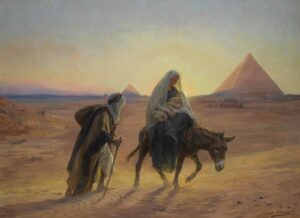
7 When did the Holy Family arrive in Egypt?
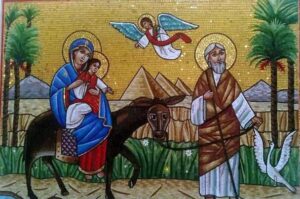
We don’t know the date. However, while we Eastern Orthodox speak of the Flight into Egypt, here is how the same event is viewed by the Coptic Church of Egypt:
“The Church celebrates the Feast of our Lord’s Entry into Egypt on the 24th day of the month of Pashons. * This feast is among the Seven Minor Feasts of the Lord. As the Holy Family entered the land of Egypt, St. Mary the Virgin mother carried the child Jesus in her arms, with Joseph the Carpenter at her side and Salome, who accompanied them.” https://copticheritage.org/20-feast-of-the-entry-into-egypt/
- This corresponds to June 1 on our calendar.
8 What did they do while they were there?
The Copts remember all the details – believe me, they do. The following is the beginning of one extensive article about their arrival and their travels immediately afterward. If you’re not Egyptian, I don’t expect you to absorb all this. I just want you to get the feel of what Our Lord and His parents went through. As refugees from Israel, they were soon also being sought by authorities in Egypt. They had to move frequently from place to place. In many of those places churches or monasteries were later founded.
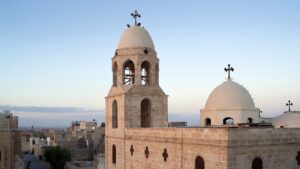
“The Holy Family entered Egypt through the Sinai desert from El-Areesh to El-Farma, which is known today as Balotha, after which they stopped at the city of Basta, now known as Tel-Basta, which is the first city in the Delta. This occurred on the 24th of Pashons, the day on which this Minor Feast is celebrated. In Tel-Basta, the Lord called forth a spring of water, and had idols topple before Him, which angered the temple priests and forced the Holy Family to head further south towards Mistard, known before as El-Mahma, literally meaning “protection.” It was called so because St. Mary protected Christ there.
“From there, the Holy Family traveled to Belbis, then to Minyat Ginah, known today as Minyat Samanoud. They then crossed the Nile to Samanoud. It is commonly known that the existing Church of St. Abanoub that lies there was built on the ruins of a much older church dedicated to St. Mary, situated on the spot were the Holy Family resided.

“From Samanoud, they traveled west to Sakha in the district of Kafr El-Sheikh, and went further west to the area now known as Wadi El-Natroun, literally meaning the “Valley of Salt,” salt extraction being common to the land. The Family departed to the city commonly known today as Ein-Shams, and from there to El-Matariya, followed by Harat Zewila, which has now become the residence of the Papal * throne after it was transferred to Cairo 350 years ago to the date of publishing this book. The Holy Family later moved to Old Cairo and they spent their time living in a cave, which is still present to this day in the Church of St. Sergius (Abu Serga).”
- The patriarch of the Coptic Church is called the Pope, which means simply “father”, “papa”. The present Pope is Tawadros II, 118th in succession to Saint Mark. The Greek (Eastern Orthodox) Patriarch of Alexandria and All Africa is Theodore II, who had a large flock in past centuries, but almost all the Greeks were finally driven out by Nasser in the 1960s.
I suspect most of these place names mean nothing to most of you. However, if you want to read the rest of this description of the Holy Family’s travels in Egypt, go to: https://copticheritage.org/20-feast-of-the-entry-into-egypt/
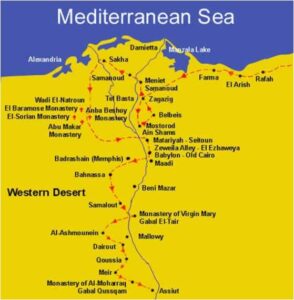
Here is a portion of yet another account:
“Idols in Abu Serga were destroyed, angering the governor and prompting him to kill the Child, and for this the Holy Family fled to Manaf, sailing from there to Upper Egypt through the River Nile, after boarding a sail boat on the banks of where the Church of St. Mary in El-Maadi now lies. El-Maadi literally means “crossing,” and it was called so because it was from there that the Holy Family crossed the Nile.
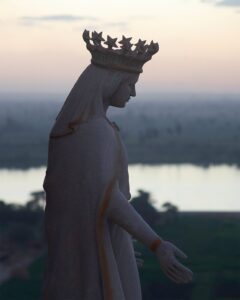
“After this, they arrived in El-Behnesa in the district of Bany Mazar, and then crossed to the western banks of the Nile to Gabal El-Teir, close to Samalot. Abu El-Makarim described in one of his writings that, while the Holy Family was sailing on the Nile, a witch pushed a huge rock causing it to roll down the mountain. The rock headed towards the Holy Family, but the Lord Christ stopped it by the palm of his hand, imprinting a mark of his palm on the rock. For this reason, the place is commonly known as Gabal Al-Kaf, meaning the “Mountain of the Palm.”
This article also continues at length, finally giving liturgical directions, but we’ll conclude here. It was written by Mikhail, Deacon Albair Gamal, The Essentials in the Deacon’s Service, (Shobra, Egypt: Shikolani, 2002), p.738 – 741. Translated from Arabic by Bishoy K. R. Dawood and Ragy Sharkawy, edited by Michael Guirguis.
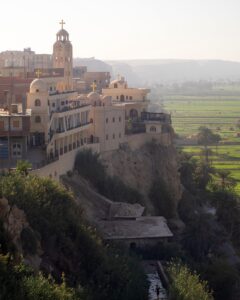
9. How long did they stay in Egypt?
“The Church scholars and historians suggest that the Holy Family spent a period of about four years in Egypt. By staying in Egypt, the prophesy of Isaiah was fulfilled: ‘See, the Lord is riding on a swift cloud and comes to Egypt; the idols of Egypt will tremble at his presence, and the heart of the Egyptians will melt within them'” (Is. 19:1). The Fathers explain that the ‘cloud’ here represents St. Mary.” copticheritage.org/20-feast-of-the-entry-into-egypt/
All told, this would mean that Jesus would have been over six years old when they returned to Nazareth. What did He remember of the trip? Considering that He was fully Human but also fully Divine, there is no way we can answer that question. *
- I who am definitely merely human (ask my wife…) remember in considerable detail our family trip to Wyoming when I was not yet seven.
10 How long was their entire trip: to Egypt, within Egypt, and then home again?
“It is estimated that the whole journey from Bethlehem to the return to Nazareth lasted over three years. They had covered approximately 1242.80 miles. Their means of transport was a weak beast of burden and the occasional sailboat on the Nile.” https://udayton.edu/imri/mary/archive.php

That seems an awfully precise “estimate” of the distance! Whatever, it was a long way walking and riding on a donkey and sailing on the Nile. Compare it to the Magi’s 1800 miles total journey, and surely they traveled in relative comfort compared to the Holy Family.
A few sources of material about the Flight to Egypt
The Egyptian government (!) has recently opened a “Holy Family Trail”, and has restored many of the sites connected with their time in Egypt:
This is a fascinating account of a family’s adventures following the Trail: https://www.bbc.com/travel/article/20221116-holy-family-trail-a-new-path-though-egypts-holiest-sites
Here are two news accounts:
“Egypt rushes to restore Biblical sites along the Holy Family Trail: https://www.cbsnews.com/news/egypt-holy-family-trail-jesus-mary-joseph-flight-to-egypt-tourism/
https://greekreporter.com/2023/12/03/holy-family-jesus-egypt/
The University of Dayton (Ohio) presents much very readable information about the Flight into Egypt: https://udayton.edu/imri/mary/f/flight-into-egypt.php
Here is a large compilation of material about the Flight, as ever from John Sanidopoulos’ excellent Blog: https://www.johnsanidopoulos.com/2017/12/flight-into-egypt-resource-page.html
Here are two sites of professional guided tours of the route of the Holy Family. By reading them you will find specifics about their time in Egypt – and perhaps you’ll be inspired to do some traveling yourself!
1 https://www.egypt-uncovered.com/tour/route-of-the-holy-family-tour /
2 https://www.journeytoegypt.com/en/activity/136238/the-journey-of-the-holy-family-to-egypt-14-days
Some personal commentary
1 I’m sure you know that the word “Coptic” has the same roots as the word “Egypt“. The Coptic Orthodox Church is part of what are called the “Oriental Orthodox”, which have been divided from our “Eastern Orthodox” Churches since the Council of Chalcedon in AD 451. Their understanding of the Person of Christ differs from ours – though a council of theologians from both sides said the difference today is only linguistic, not theological. They have a somewhat different form of the Divine Liturgy, but our spirituality is very much alike – much closer than is ours with Western Christianity.

2 The Coptic Orthodox Church is still alive and well, despite some persecution by radical Muslims and much emigration of its members to the West. Church statistics are notably unreliable: However, the most common estimate is that there are about ten million Coptic Orthodox in Egypt *, and at least twice that many in other countries. The government of Egypt officially protects the Church, as well as other minorities, though mistreatment of Christians is sometime overlooked. Here is a U.S. Government report on the subject: https://www.state.gov/reports/2021-report-on-international-religious-freedom/egypt/
- Coptic Orthodox are about 10% of the Egyptian population of 110 million. American Eastern Orthodox claim we have 6 million members (on a good day). If so, we are about 1.8 % of the US population of 332 million.
3 Are the stories about the Holy Family in Egypt credible?

The basic accounts reflect a number of “apocryphal” writings. “Apocryphal”, in this case, means not part of the accepted Holy Scriptures. That doesn’t mean they’re entirely inaccurate. * It means only that apocryphal texts should be approached very carefully, as indeed should all accounts of history. I suspect most of these apocryphal writings reflected stories about the Holy Family long pre-existent in Egypt. Why else would their visit to Egypt be remembered in such detail, commemorating events of their life there with so many ancient churches and monasteries?
* Our Eastern Orthodox Church celebrates a number of feasts found only in apocryphal writing: the Conception, Nativity and Falling Asleep of the Virgin Mary, for example.
Also, some skeptics have pointed out that the Gospels’ dating of the story of Christ’s Birth and the Flight and Return do not correspond altogether with the similar dating in the secular accounts – regarding when certain rulers lived and died, for example. Who is incorrect about the dates and who’s not is hard to say. I don’t think minor differences in dating are important. What matters is whether the events took place. I published last week’s Post four days off my regular schedule. That didn’t mean I didn’t publish it, or cause the information in it to be incorrect.
 4 Note that the Coptic icons reflect the earliest tradition that Joseph was an old man.
4 Note that the Coptic icons reflect the earliest tradition that Joseph was an old man.
5 The Holy Family were refugees with all that word “refugees” entails. They had no family in Egypt. They felt the same as all strangers do in a foreign land. Joseph would have found little work as a τέκτων, a “craftsman”, a “carpenter”, in that country where trees are few and far between. At least, as of 2023, 0.1% of Egypt is forested.
In His famous Parable of the Sheep and the Goats, Christ told His followers: “For I was hungry and you gave me something to eat, I was thirsty and you gave me something to drink, I was a stranger and you invited Me in”. I believe He was thinking back to His time in Egypt, when He and His Family were needy strangers, refugees whom some people welcomed. And some did not: “I was hungry and you gave me nothing to eat, I was thirsty and you gave me nothing to drink, I was a stranger and you did not invite me in.”
Surely today’s subject has some application to our current refugee issue, which with global warming is only going to get worse. I have no easy answers. But, brothers and sisters, if we just ignore true refugees, Who else are we ignoring?… I’ll leave it to you to work out the details.
Next Week’s Post: Let’s get to know Saint John Chrysostom
Week after Next: Saint Brigid of Kildare